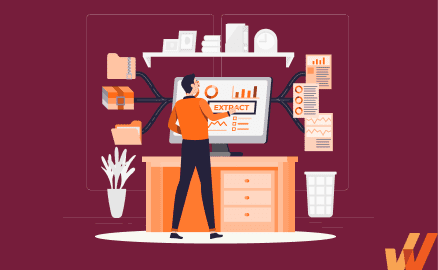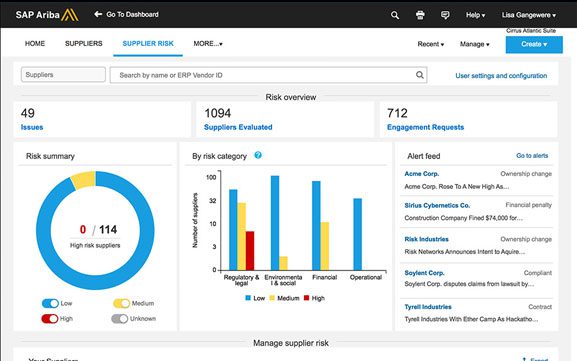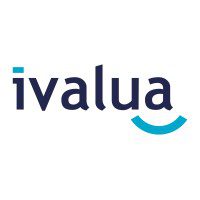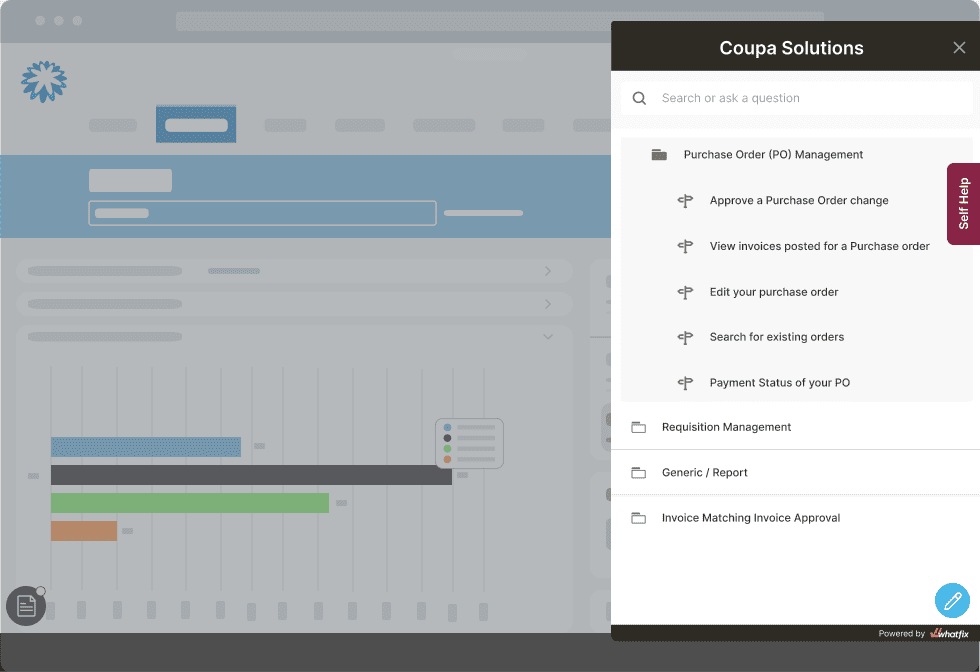12 Best Procurement Software in 2024
- Published: October 6, 2022
- Updated: April 24, 2024


Procurement processes can be complicated for businesses, and all of them are crucial for the success of the company, one of the most important is managing orders, invoices, and inventory.
If the way you manage and track purchases, products, suppliers, vendors, and payments doesn’t work as intended or is overly complicated, everything else falls apart. Thankfully, procurement software can manage or automate those processes for you.
What is the best procurement software in 2024?
- SAP Ariba
- Coupa Procurement
- Team Procure
- Procurify
- GET SMART
- Precoro
- Netsuite Procurement
- Oracle Procurement Cloud
- Ivalua
- Jaggaer
- Zycus Source-to-Pay
- Kissflow
What is Procurement Software?
Procurement software manages the e-procurement lifecycle, from purchasing materials and managing inventory to generating purchase orders and overseeing bills and payments. It helps identify inventory shortages before it impacts your bottom line, gathers data to help improve profitability, and automates reminders about purchase orders or cancellations.

Procurement software takes some of the pressure off your team so they can focus on more important work. With the right procurement software, your inventory and purchasing processes will run smoothly without intervention from your team.

Common Procurement Challenges
Procurement teams face various challenges in their day-to-day roles, and procurement software can help alleviate them. Some of the most common procurement challenges include:
- Cost management: Finding quality vendors and software within tight budget constraints.
- Supplier management: Ensuring and maintaining the quality of suppliers.
- Risk management: Identifying risks in the supply chain and mitigating fraud.
- Compliance: Adhering to strict, often opaque laws and regulations.
- Integration: Making sure all new technologies integrate with existing and disparate systems.
To help your teams overcome these common challenges, you can lean on procurement software. Here is how procurement software can help address these challenges:
- Cost management: Automated budget tracking and real-time cost analysis.
- Supplier management: Supplier evaluation tools and intelligent monitoring of supplier relations.
- Risk management: Identify risks and potential fraud through data analysis.
- Compliance: Maintain compliance with automated updates and regulatory checks.
- Integration: Streamline integration processes and reduce human error.
Finding the right procurement software can drastically improve the efficiency of your procurement team and process, not to mention improve their day-to-day by mitigating friction points.
Features of Procurement Software
Every procurement software provider will have pros and cons, and you should consider these when choosing which software is right for your business. However, some standard features should be present in most procurement software options you evaluate.
These features include:
- Supplier management: Tools for tracking supplier information and performance.
- Purchase order management: Creation, tracking, and management of purchase orders.
- Cost analysis: Automated budget analysis to monitor spending to identify potential savings.
- Contract management: Manage contracts and ensure compliance.
- Inventory management: Track stock levels and automatically reorder when necessary
- E-Procurement: Enable online procurement processes.
Make sure any procurement software you’re considering includes these standard features.
Types of Procurement Software
There are multiple kinds of procurement software. Here are the five common types:
- Accounts Payable Software
- Procure-to-Pay (P2P) Software
- Source-to-Pay (S2P) Software
- Purchasing Software
- Request for Proposal (RFP) Software
1. Accounts Payable Software
Accounts payable process automation keeps track of when bills are due. With accounts payable software, you can automatically monitor the status of your bills and when they need to be paid. You can also use the software to schedule payments, so you never miss an important deadline.
2. Procure-to-Pay (P2P) Software
Procure-to-pay (P2P) software is used to manage to procure and pay for goods and services, including keeping an eye on spending and ensuring compliance. P2P software helps streamline procurement and payment processes to increase efficiency and productivity.
3. Source-to-Pay (S2P) Software
Source-to-pay (S2P) software handles finding, negotiating, and contracting goods. S2P software helps your team stay on top of the procurement and purchasing processes to drive more business value and improve savings.
4. Purchasing Software
Purchasing software automates the entire source, procurement, and payment cycle. It helps users control their purchasing processes to make smarter decisions that drive efficiency.
5. Request for Proposal (RFP) Software
RFP and RFx software is used to manage your proposals. It can create proposal templates, track outstanding proposal statuses, and even collect signatures.
What to Consider When Purchasing Procurement Software
When choosing a procurement tool for your business, here are the key things you should look out for and consider:
- Simple UI. An easy-to-use interface will make it easier for your team to adjust and use your new tool. Choosing a simple UI can help your team get up to speed faster so you realize the true value of your software sooner.
- Communication and collaboration tools. Keeping relevant conversations about procurement decisions or contracts in your software can ensure everyone has the information they need to make appropriate decisions.
- Budget insights. When purchasing new materials, you need to keep an eye on your budget. A tool with insights to your budget will make it easier to identify when you’re a risk for spending too much.
- Automation. Automation tools drive productivity and efficiency. Procurement software with automation tools can help you improve accuracy, reduce errors, and keep processes running smoothly.
- Integrations. Your procurement processes impact other areas across your organization. Integrating other important tools with your procurement software can keep data updated and accurate without extra work from your team.
- Implementation and adoption strategy. While procurement software vendors will promise quick ROI, the reality is that without a change and onboarding strategy built around the people using this new technology (employees, suppliers, vendors), your end-users will fail find value in the tool with low digital procurement adoption.

12 Best Procurement Software in 2024
Here are the best procurement software applications, including review ratings, pricing, and a description of each platform and vendor.

1. SAP Ariba
- Review Rating: 4 out of 5 stars
- Pricing: Custom pricing
SAP Ariba is an e-procurement and supply chain cloud solution for large and midsize companies. It’s a source-to-pay tool that gives you complete control over spending, savings, and your supply chain. SAP Ariba uses innovative technology to help you optimize your procurement processes, including natural language processing for easy search and AI to educate users.
Read our blog post to learn more about SAP Ariba implementation.

Other SAP Ariba features include:
- Connectivity with the SAP Business Network for greater collaboration and connection
- Use analytics, data sources, and integrated solutions to identify buying trends
- Manage global spending and compliance all in one place

2. Coupa Procurement
- Review Rating: 4.1 out of 5 stars
- Pricing: Custom pricing
Coupa is a sophisticated purchasing tool that prioritizes the customer experience. You’ll get visibility into your procurement and buying cycle to maximize spend under management, gain visibility and control, and ensure overall value. Check out our post on Coupa implementation to learn more.

Coupa Procurement features include:
- Creating and managing contracts and catalogs, including approvals, punch-outs, and more.
- Easy-to-use buying processes for goods and services
- Inventory management to keep track of stockrooms and on-hand inventory
- Budget checks and approvals to cut down on overspending

3. Team Procure
- Review Rating: N/A
- Pricing: Starts at $25 per user a month
Team Procure is a relatively new cloud procurement platform that covers everything from purchase requests and orders to supplier and warehouse management. It offers platforms and tools that fit the need of every size business and has custom API integrations to fit your unique needs.

Other Team Procure features include:
- Manage RFQ and e-auction bids from multiple suppliers
- Create custom workflows to get appropriate approvals and sign-offs
- Track supplier performance with built-in KPIs and performance metrics
- Track warehouse performance across multiple locations

4. Procurify
- Review Rating: 4.6 out of 5 stars
- Pricing: Custom pricing
Procurify is an all-in-one spend management platform that helps companies manage their spending without slowing down processes. With Procurify, you can customize budgets in real-time, gather approvals, and even provide spending cards to make it easier for team members to buy what they need right when they need it. The Procurify mobile app also simplifies the purchasing process when team members are on the go.

Procurify can also:
- Automate purchasing workflows to save your team time
- Manage approved vendors so your employees can make smarter purchasing decisions
- Integrate with your favorite business management tools
- Give real-time insights to keep an eye on a budget before approving a purchase, not after

5. GEP SMART
- Review Rating: 4.4 out of 5 stars
- Pricing: Custom pricing
GEP SMART is an AI-powered S2P software that empowers organizations with direct and indirect procurement solutions.
GEP SMART’s suite of capabilities and digital tools enables enterprises to digitalize their entire source-to-pay process into one unified system.
GEP SMART provides capabilities such as spend analysis, sourcing, contract management, supplier and vendor management, and of course procure-to-pay.

Additional GEP SMART features include:
- AI-powered platform tailored to your procurement process needs.
- Spend and saving analysis for better cost management.
- End-to-end supplier and vendor management.
- Field-tested procurement process standardization and workflow management.

6. Precoro
- Review Rating: 4 out of 5 stars
- Pricing: Custom pricing
Precoro is procurement software that helps eliminate manual errors, reduce expenses, and save time. Teams can use Precoro to generate purchase orders, approve process steps, and generate reports. Precoro can also manage budgets, track inventory, and integrate with the tools you’re already using.

Additional Precoro features include:
- Product catalog for a positive eCommerce experience
- Mobile on-the-go approval
- Smart notifications
- Visual, standard, and custom reporting options with 20 filters and 120+ customizable fields

7. Netsuite Procurement
- Review Rating: 3.9 out of 5 stars
- Pricing: Custom pricing
Netsuite Procurement streamlines the process of buying goods and services by managing vendors all in one place. Generate real-time views into spend and vendor performance and improve communication and collaboration throughout the process. Netsuite Procurement helps increase profitability, enhance visibility, and improve relationships with partners and vendors. It’s also an Oracle suite product, meaning it has native-integration abilities with all other Oracle and Netsuite ecosystem products.

Netsuite Procurement can also:
- Make it easier for employees to select vendors capable of providing the quality services or goods they need
- Track purchases and manage inventory
- Manage and process vendor payments with automated systems
- Ensure vendor compliance with regulations and standards

8. Oracle Procurement Cloud
- Review Rating: 4.1 out of 5 stars
- Pricing: Starts at $405 per user, per month
Oracle Procurement Cloud automates procure-to-pay, strategic sourcing, and supplier management all-in-one. It streamlines the shopping experience to improve spend management and increase business value. Manage even the most complex procurement processes to keep risk in check and ensure all your projects are moving along smoothly.

Additional Oracle Procurement Cloud features include:
- Optimize productivity with built-in collaboration, editing and approval workflows, and guided authoring
- Manage and track the entire contract lifecycle and enable standards compliance
- Use analytics to drive business value and identify new opportunities
- Enhance supplier collaboration and build stronger vendor relationships

9. Ivalua
- Review Rating: 4 out of 5 stars
- Pricing: Custom pricing
Ivalua is a single S2P platform that handles all aspects of managing supplier relationships and spending. It has automation tools to help streamline processes and free up team capacity and collaboration tools to strengthen connections with suppliers. Built-in insights can also help you and your team make better decisions.

Ivalua can also:
- Provide transparency into your procurement process with end-to-end analytics across S2P
- Secure information sharing for enhanced security while maintaining collaboration
- Digitize the entire S2P process for a consistent user experience
- Maximize your ROI and minimize risk with quick deployment and adoption

10. Jaggaer
- Review Rating: 4.5 out of 5 stars
- Pricing: Custom pricing
Jaggaer uses a concept it calls “autonomous commerce” to help B2B brands improve their commerce experience. It uses modular solutions to create custom digital platforms that transform the entire source-to-pay spectrum. Jaggaer covers everything from analytics, category management, supplier management, sourcing, contracts, invoicing, and more.

Additional Jaggaer features include:
- Optimized contract compliance and guided buying experiences
- Flexible integrations to connect with the tools you’re already using
- Self-service support and portals to improve efficiency
- Inventory management to decrease redundant purchases

11. Zycus Source-to-Pay
- Review Rating: 3.6 out of 5 stars
- Pricing: Custom pricing
Zycus allows teams to infuse the power of AI to optimize your procurement process. Zycus procurement software uses data to drive actionable insights and increase efficiency. Integrate with leading technologies to get deeper insights and build better experiences for your customers and employees — all on an easy-to-use digital procurement and S2P platform.

Zycus Source-to-Pay features include:
- Uses spend analysis to unlock potential savings
- Manages supplier risk and assesses performance
- Provides a collaborative environment with a built-in supplier network
- Manages procurement requires and projects in one tool

12. Kissflow
- Review Rating: 4.8 out of 5 stars
- Pricing: Starts at $1,990 per month
Kissflow’s procurement software is a flexible platform that puts you in complete control of your business. It keeps things simple while still providing all the features and tools you need to optimize and improve your procurement process, including analytics, vendor management, invoice management, and purchase requests.

Additional Kissflow procurement features include:
- Three-way matching to match invoices with goods receipts and purchase orders
- Budget management and spend control with custom rules and approvals
- Drag-and-drop customization of workflows and tools
- Integrations to seamlessly connect with your finance and operations software
Procurement software is complex, and enterprises must build customized processes and workflows that help them achieve e-procurement objectives and goals.
Finding ROI from your procurement software investment depends on how well you prepare and support your procurement software end-users – ie. the employees, suppliers, and vendors using the platform.
With a digital adoption platform (DAP) like Whatfix, organizations can enable end-users with contextual, in-app guided experiences and self-help support to unlock the true potential of procurement applications and digital processes.

With Whatfix, enable your procurement end-users by:
- Guiding users through the procurement system’s features, tasks, and processes with interactive flows, tours, and task lists.
- Alerting and nudging users with in-app smart tips, beacons, and field validations.
- Providing users with Self Help, which crawls your organization’s knowledge and documentation and curates it into a searchable, embedded self-help wiki that provides a help center for your end-users.

Whatfix for procurement and S2P applications puts the information and context your employees need right within the application, guiding them precisely when they need it most. Automate your processes and boost employee productivity while ensuring you get the most out of your new procurement software investment.

With Whatfix, teams can also understand how end-users engage with your procurement software, allowing you to understand:
- How long it takes for employees to become proficient with your procurement software.
- What help content is the most helpful, and what new content you should create.
- Where there are friction points that your end-users are struggling with.
- What features are (and aren’t) being adopted and used properly.
Software clicks better with Whatfix's digital adoption platform
Enable your employees with in-app guidance, self-help support, process changes alerts, pop-ups for department announcements, and field validations to improve data accuracy.
Thank you for subscribing!


